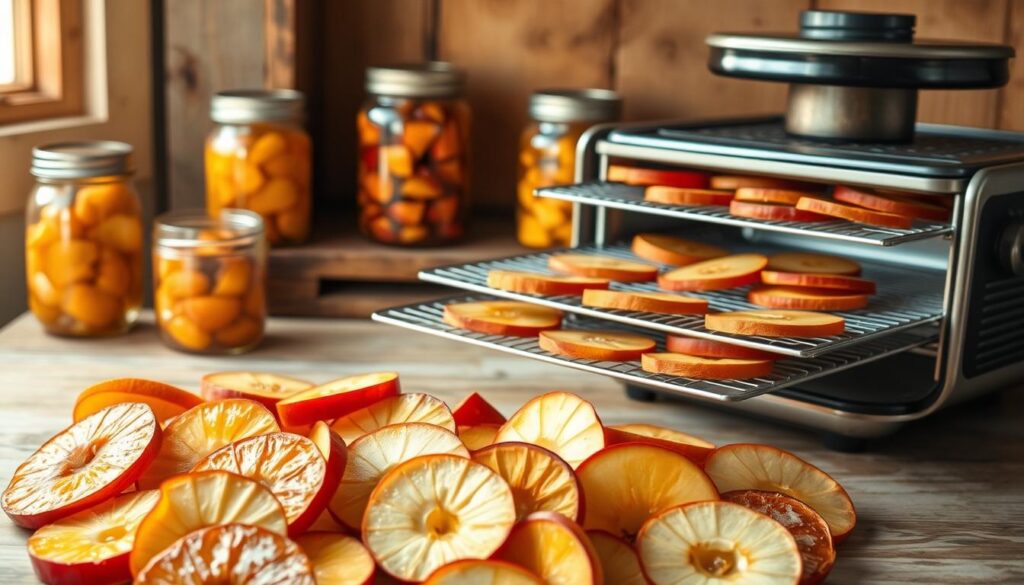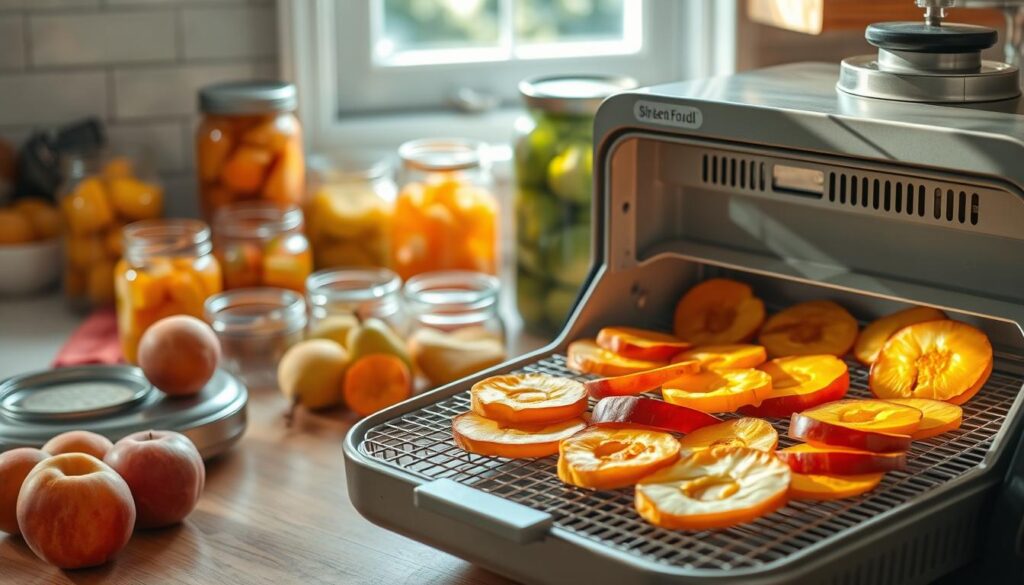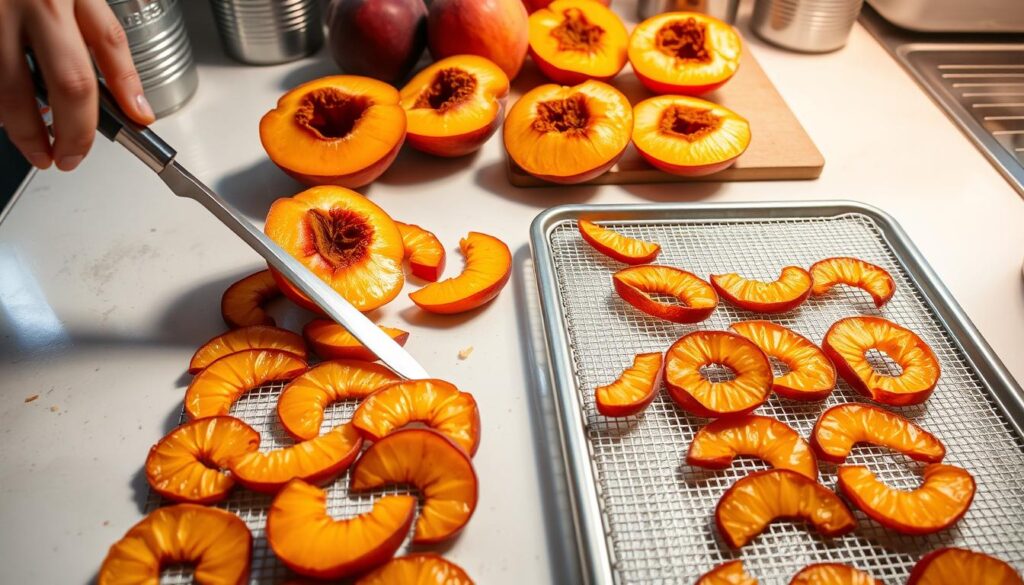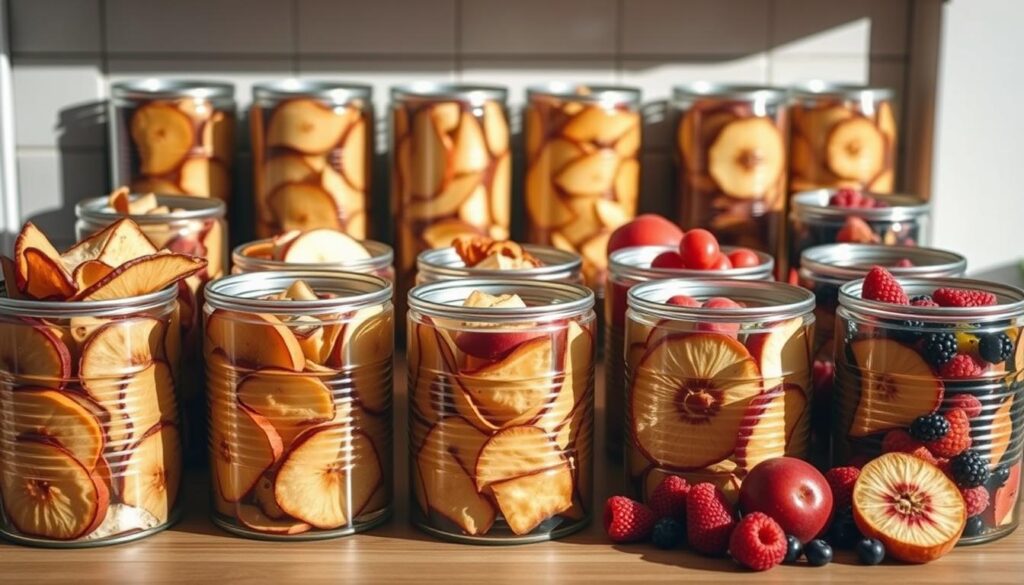Ever thought about turning that unused canned fruit into a crunchy snack? Dehydrating canned fruit is not only possible but also a smart way to reduce waste and get creative in the kitchen. This guide will show you how to do it step by step and clear up any myths.
If you’re a backpacker looking for light snacks or a home cook wanting to cut down on waste, you’re in the right place. We’ll cover everything from choosing the right equipment to storing your dried fruit. Discover how to turn sweet peaches or pears into tasty, long-lasting treats.

Key Takeaways
- Dehydrating canned fruit works even when fruits are packed in syrup or juice.
- Home ovens or basic dehydrators work—no professional gear required.
- Proper prep methods vary by fruit type to avoid sogginess or spoilage.
- Stored correctly, dried canned fruit lasts months, saving money and cutting waste.
- Rehydrated fruit adds flavor to recipes like oatmeal or energy bars.
Can You Dehydrate Canned Fruit?
Yes, you can dehydrate fruits from a can. This turns canned fruit into easy-to-carry snacks by removing moisture. Even though the fruit is processed, it can be dried to last longer and be used in new ways.
Why Dehydrating Canned Fruit Works
The canning process doesn’t stop moisture from being removed. Canned fruit, even if pre-cooked, has enough water for drying. Just drain the syrup, cut the fruit, and dry it.
The heat from dehydrators or ovens turns the liquid into vapor. This leaves the fruit dry and chewy. You don’t need to worry about syrup or juice getting in the way. Just rinse the fruit first.
Differences Between Fresh and Canned Fruit Dehydration
- Prep time: Canned fruit needs rinsing and draining before slicing, adding a step compared to fresh.
- Time in dehydrator: Canned fruit may take longer—up to 6 hours—due to initial softness.
- Texture: Canned varieties tend to stay softer, while fresh produce dries crisper.
- Flavor: Canned fruit often retains a sweeter taste from syrup, intensifying during drying.
Common Misconceptions About Dehydrating Canned Fruit
Many think syrup stops drying, but draining fixes that. Others worry the result will be soggy, but drying removes excess moisture. Even if the fruit was cooked before canning, it dries well when processed right.
You can enjoy chewy dried apples or apricots, just like store-bought snacks.
Benefits of Dehydrating Canned Fruit
Dehydrating canned fruits safely offers many benefits. It makes snacks last for months without needing the fridge. This is great for emergency kits or pantry storage. It also makes snacks lighter and easier to carry, perfect for backpackers or those with small kitchens.

- Time-saving prep: Canned fruits are already peeled and sliced, cutting prep time by half compared to fresh varieties.
- Flavor enhancement: Removing water concentrates natural sweetness, reducing reliance on added sugars.
- Cost-effective: Stock up on canned fruits during sales and dehydrate them to stretch your grocery budget.
- Nutrient retention: Proper dehydration preserves vitamins like vitamin C better than long-term canning storage.
When dehydrating canned fruit, choose varieties without added sugar for healthier snacks. Keep dehydrated slices in airtight containers to stay crisp. These snacks are great in trail mixes, yogurt, or as quick energy boosts. Always ensure fruits are fully dried to prevent mold. Dehydrating canned fruit is a smart way to enjoy seasonal flavors all year.
Essential Equipment for Dehydrating Canned Fruits at Home
Getting the right tools is key to success when dehydrating canned fruits at home. Whether you’re new or experienced, the right gear makes the process smoother and better.
Food Dehydrators vs. Ovens
Dedicated food dehydrators, like the Excalibur 3926TB, control temperature well. They dry food evenly at 135–165°F. Ovens can work, but they need lower heat and more checking. Dehydrators are faster and use less energy, making them the best way to dehydrate canned fruit in bulk.
Additional Tools That Make the Process Easier
- Mesh drying trays: These let air flow for even drying, great for small pieces like diced pineapple or peaches.
- Sharp kitchen shears: Tools like OXO Good Grips make cutting fruit into strips easy.
- Digital thermometer: A Thermapen or analog probe keeps temperatures steady, preventing sogginess.
Budget-Friendly Equipment Options
For less money, look at the Nesco Compact Snackmaster dehydrator ($50–$100) or use an oven. DIY fans can use a yogurt maker on low heat as a cheap option. Add silicone mats to prevent sticking, found at most kitchen stores.
Preparing Canned Fruit for Dehydration
Before you start, make sure your dehydrating canned fruit goes well. Follow these tips for dehydrating canned fruit to get even drying and keep the flavor.

Draining and Rinsing Techniques
First, drain off extra syrup. Use a colander for 10 minutes to get rid of the liquid. For sticky fruits like peaches, gently pat slices with paper towels. Only rinse if the syrup is too thick—don’t wash too much to keep natural sugars.
- Colander draining: Removes excess liquid quickly
- Paper towel blotting: Dries surfaces without bruising
- Rinse sparingly: Only for overly syrupy fruits
Cutting and Arranging for Optimal Results
Make sure all cuts are the same size for even drying. Cut fruits into ¼-inch thickness. Place pieces ½ inch apart on trays for good airflow. Here’s a guide for popular fruits:
| Fruit | Cut Style | Tray Spacing |
|---|---|---|
| Pineapple | ½-inch rings | 1-inch gaps |
| Peaches | 1/4-inch slices | ½-inch gaps |
| Apricots | Halves (pits removed) | ¾-inch gaps |
Pre-Treatment Options
Pre-treatments can make your fruit better. Dip in a lemon juice bath (1 part lemon juice to 3 parts water) to stop browning. For sweetness, mix with honey or cinnamon before drying. Soft fruits like mandarin oranges should be gently patted dry with a clean cloth before drying.
- Acidic treatments: Lemon juice prevents browning
- Sweetness boost: Honey adds flavor without extra moisture
- Soft fruits: Pat dry gently before arranging
Best Types of Canned Fruit for Dehydration
Choosing the right canned fruits is key for dehydrating fruits in cans. Pineapple, peaches, pears, and mandarin oranges are top choices. They are firm, sweet, and keep their shape well.

| Fruit | Why It Works | Best Use |
|---|---|---|
| Pineapple | Low moisture, holds shape | Snacks, baking |
| Peaches | Sweetness intensifies | Granola, salads |
| Pears | Soft texture stays pliable | Yogurt, oatmeal |
| Mandarin Oranges | Segments dry evenly | Trail mixes, desserts |
Canned berries and juicy fruits like cherries don’t work well. They have too much water. Choose cans that say “juice packed” or “light syrup” for better results. Look for brands like Del Monte or S&W with fewer additives.
For the best way to dehydrate canned fruit, pick low-moisture options. Avoid fruits in heavy syrup because the sugar crystallizes and sticks. Always drain and pat dry before starting to ensure even dehydration.
Step-by-Step Guide to Dehydrating Fruits from a Can

Learning to dehydrate fruit from a can is easy with the right steps. This guide will help you turn canned peaches, pears, or pineapple into tasty snacks. You can make them crispy or chewy.
Temperature Settings and Timing Guidelines
First, set your dehydrator or oven to 135–145°F. Because canned fruit has more moisture, it dries longer than fresh fruit. Here’s a basic drying schedule:
| Fruit | Temp (°F) | Time (hours) |
|---|---|---|
| Peaches | 135–140 | 6–8 |
| Pineapple | 140 | 4–6 |
| Apricots | 135 | 8–10 |
Remember to rotate your trays every 2 hours. This ensures your fruit dries evenly.
How to Tell When Your Fruit Is Properly Dehydrated
Look for these signs to know if your fruit is dry:
- Flexibility: The fruit bends but doesn’t stick together.
- No sticky spots: The edges should feel dry.
- Cool test: Let it cool for 1–2 hours. If the edges curl or crack, it’s ready.
Troubleshooting Common Problems
| Issue | Possible Cause | Solution |
|---|---|---|
| Fruit remains sticky | Inadequate drying time | Extend drying by 1–2 hours. |
| Uneven drying | Poor air circulation | Rotate trays; space fruit evenly. |
| Overly brittle pieces | Temperature too high | Lower heat to 130°F and monitor closely. |
Always make sure to dehydrate canned fruits safely. Check moisture levels before storing them.
Storing Your Dehydrated Canned Fruit Properly
Proper storage keeps your dehydrated canned fruits fresh and safe. Follow these steps to protect your efforts in dehydrating canned fruits at home. This will help extend their shelf life.
Container Options for Maximum Shelf Life
Choose the right container to keep flavor and freshness locked in. Here are some options to consider:
| Container | Pros | Cons |
|---|---|---|
| Glass jars | Airtight, reusable, see contents | Heavy, may break |
| Mylar bags | Oxygen barrier, lightweight | Single-use, bulkier |
| Vacuum-sealed bags | Longest shelf life | Requires vacuum sealer |
| Food-grade plastic | Lightweight, affordable | Less durable |
Ideal Storage Conditions
Store containers in a cool, dry, and dark place. Keep temperatures below 60°F (15°C) and humidity under 15%. Avoid sunlight or heat sources to prevent moisture buildup. This is key for dehydrating canned fruits safely.
Signs of Spoilage to Watch For
- Fuzzy growth or discoloration
- Clumping or stickiness
- Off odors like sourness or ammonia
If you see these signs, throw out the batch. Always use older stock first. Label containers with dates to keep track of freshness.
Creative Ways to Use Dehydrated Canned Fruit
Dehydrating canned fruit opens up new ways to use it. You can turn it into kitchen staples with these ideas:
| Use | How to Apply | Benefits |
|---|---|---|
| Baking | Add to cookies, scones, or quick breads for intense flavor | Moisture-free texture prevents soggy baked goods |
| Trail Mix | Mix with nuts, dark chocolate, and seeds for energy bites | Long shelf life for camping or workday snacks |
| Smoothies | Soak pieces overnight then blend for creamy texture | Enhances thickness without added sugar |
| Cocktails | Muddle with spirits to infuse flavors like mango or pineapple | Perfect for tropical-themed drinks |
| Salads | Crunchy dried apple or pear slices on greens | Adds texture without wilting |
Try grinding dried fruit into powders for homemade spice blends. Dehydrating canned fruit also lets you make no-bake energy balls with peanut butter and oats. These methods show can you dehydrate canned fruit? is more than yes—it’s a start to culinary creativity. Use dried lemon zest on yogurt or dried cranberries in grain bowls. With a bit of creativity, every batch can be a pantry multitasker.
Nutritional Considerations When Dehydrating Fruits from Cans
When you dehydrate fruits in cans, the flavors and nutrients get more intense. But, sugar levels and vitamins can change. Here’s how to keep your snacks healthy.
Sugar Content and Health Implications
Canned fruits often have added sugars, like those in syrup. These sugars get even more concentrated when dehydrated. For example, a half-cup of canned peaches in heavy syrup has 20g of sugar before drying. After drying, this amount stays the same but takes up less space. To cut down on sugar:
- Choose fruits canned in water or 100% juice
- Rinse fruit in cold water before drying
- Limit portions to ¼ cup servings
Preserving Nutrients During the Dehydration Process
Dehydrating at low heat helps keep most minerals and fiber. But, vitamins like C can drop by 20-30% during drying. Here’s a comparison of nutritional values:
| Category | Fresh | Canned | Dehydrated |
|---|---|---|---|
| Sugar Content | Natural sugars only | Added sugars common | Concentrated sugars |
| Vitamin C | High | 50% retained | 30% retained |
| Fiber | Medium | Same as fresh | Increased density |
| Calories | Low per volume | Varies with syrup | Higher per serving |
By picking low-sugar canned options and storing them right, you can enjoy dehydrated snacks. They’ll have fiber and important minerals like potassium and manganese. Always check the label for sugar content before you start.
Conclusion: Making the Most of Your Dehydrated Canned Fruit
Dehydrating canned fruits safely opens up new possibilities for preserving and enjoying your favorite foods. By following the best way to dehydrate canned fruit, you ensure a process that maximizes flavor and nutrition. Start by selecting canned fruits with minimal added sugars and drain them thoroughly before drying.
Use a food dehydrator or oven set to the right temperature, as outlined earlier, to maintain quality. This way, you get the most out of your dried fruit.
Proper storage in airtight containers keeps your dried fruit fresh for months. It’s perfect for snacks, recipes, or emergency supplies. Always check for spoilage signs like off odors or mold, and clean equipment to avoid contamination.
Whether you choose apples, peaches, or pears, experimenting with different fruits and uses can add variety to your meals. From trail mix to baking, the possibilities are endless.
Mastering this technique requires attention to preparation steps and drying times. Always refer to the temperature guidelines and monitor progress closely to prevent over-drying. With practice, you’ll find dehydrating canned fruits is both practical and rewarding.
Incorporate this method into your kitchen routine to reduce waste, save space, and enjoy tasty, portable snacks year-round. Your pantry and creativity will thank you.
FAQ
Can you dehydrate canned fruit?
Yes, you can dehydrate canned fruit successfully. You can remove the moisture from canned fruit. This makes it lightweight and shelf-stable for snacks.
What is the best way to dehydrate canned fruit?
First, drain and rinse the fruit to remove excess syrup. Cut it into uniform pieces for even drying. Use a food dehydrator at the right temperature for the fruit type.
Are there benefits to dehydrating canned fruits?
Dehydrating canned fruits extends their shelf life. It reduces weight and storage space. It also saves preparation time and intensifies flavors, making them convenient for snacks and meals.
What types of canned fruit work best for dehydration?
Canned fruits like pineapple, peaches, pears, and mandarin oranges dehydrate well. They keep their structure and flavor. Avoid canned berries because they have high moisture and are small, making dehydration hard.
How do you store dehydrated canned fruits?
Store them in airtight containers like glass jars with seals or mylar bags with oxygen absorbers. Vacuum-sealed bags also work well. Keep them in a cool, dark, and dry place for the longest shelf life.
What signs indicate spoilage in dehydrated fruits?
Look for color, texture, odor changes, or moisture or mold. These signs mean the fruit has gone bad and should be thrown away.
Can you add flavors when dehydrating canned fruit?
Yes, you can enhance flavors by using lemon juice baths, honey dips, or sprinkling spices before dehydration. This creates unique and tasty snacks.
Is it safe to dehydrate canned fruits?
Dehydrating canned fruits is safe if you follow proper methods. Make sure to remove enough moisture to prevent mold. Also, store them properly to keep quality.
Can you use a regular oven for dehydrating fruits from a can?
Yes, you can use a regular oven for dehydrating canned fruits. But, dedicated food dehydrators usually give better temperature control and results.
What are some creative uses for dehydrated canned fruits?
Dehydrated canned fruits can be used in oatmeal, yogurt, baked goods, trail mixes, or even to infuse spirits for cocktails. They are versatile and not just for snacking.
